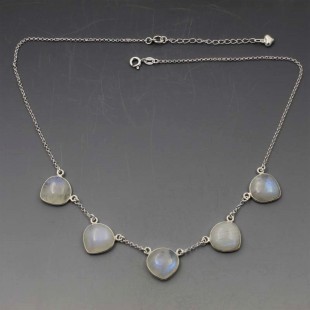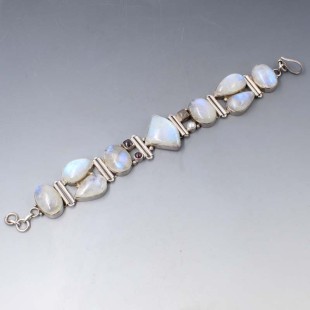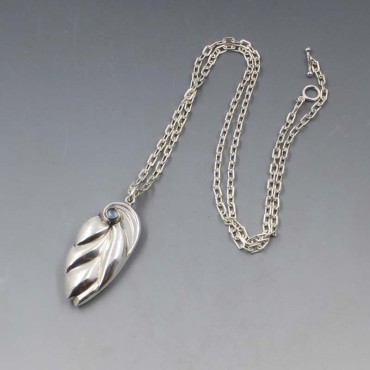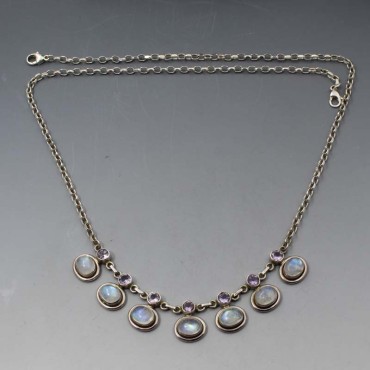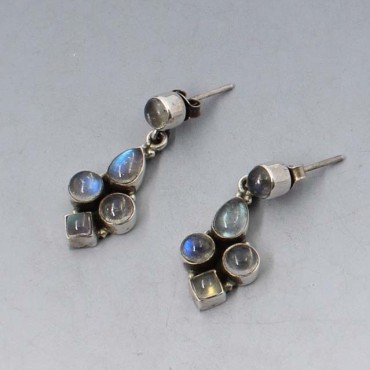Sale 10 % Off. Enter code NEW10 at checkout. (Add item to cart, click on black cart icon, then "VIEW CART", then "Use Coupon Code").
All About Moonstone Jewellery
ALL ABOUT MOONSTONE JEWELLERY
Moonstone is the opalescent variety of orthoclase. Traditionally thought to be a good luck stone and linked to romantic passion, it was often offered as a gift between lovers. Moonstone can be transparent with a stong blue hue on the surface, or it can be milky with the appearance of inner light . It can have a striking cats eye or star effect.The hue is the result of the light reflecting off alternating layers of albite and orthoclase feldspar. The thin albite layers produce the desirable blue tone and the thick orthoclase layers create the white hue or "schiller". Moonstone comes in a variety of colours and can possess many different qualities.
Gold and Silver Moonstone Necklaces below: Left - Gold moonstone necklace with cabochons in gold vermeil settings. Centre - long moonstone necklace with round moonstone gems bezel set in sterling silver settings along a silver chain. Right - sterling silver and moonstone necklace with silver chain.
WHAT TO LOOK FOR IN A MOONSTONE
Unlike other gemstones such as emeralds and sapphires moonstones are usually not artificially enhanced to improve their value and colour. Moonstones come by their features honestly. What you should look for in a moonstone is something called "schiller," which is basically the moonstone's lustre when polished. Schiller results from the light bouncing off the moonstone’s thin layers of albite (which produce blue hues) and thicker layers of orthoclase feldspar (which provide the white, pearly, moon-like glow). To enhance the schiller in a specific bit of moonstone, the mineral is generally formed into a round shaped cabochon, worn in a pendant or ring, in which each layer of the stone runs parallel to the flat base of the cabochon. However, that said, moonstones with imperfections, or inclusions inside the stone are also prized since they can provide dazzling cat’s-eye effects. Less frequently, moonstones are specially carved into cameos (their hardness of about 6 on the Mohs scale allows this in comparison, diamonds are at the top of the scale with a10). Because moonstones are of hard enough quality to facet . they are sometimes are cut into cushion shapes, however the stone can be brittle, so cut moonstones are usually.
Moonstone Jewellery below: Left - chunky silver and moonstone bracelet with garnet and pearls. Centre - vintage Peter Jenner silver moonstone and fire opal necklace. Right - rectangular moonstone and sterling silver ring .
BENEFITS OF MOONSTONE
Moonstone is generally associated with the Moon and
is know as a very beneficial stone for women. A stone of insight and
intuition , moonstone is thought to help balance any aggressive tendencies in the emotional body in both males and females. Many people
find moonstone to be quite soothing and it is used to help relieve
stress. Physically, Moonstone is believed to assist conception by aiding
all parts of the reproductive system, and moonstone is known for its power to
balance menstrual and hormonal cycles. It also aides the digestive
system, including the liver, and can help in the absorption of essential
mineral and vitamins
Below - vintage and antique moonstone jewellery: Left George Jensen silver and moonstone pendant 360B, centre - blue moonstone necklace with amethysts, and blue moonstone and silver earrings
TYPES OF MOONSTONE
Blue Moonstone
Blue moonstone is transparent and crystal clear with a floating blue
tone on the surface.The most desirable stones have the most intense blue
colour. The largest and best stones have traditionally come from
Myanmar(Burma), however it has become much harder to find good stones and
therefore the price has increased. Blue moonstone is sometimes faceted,however
care needs to be taken when working with it, as the material can be brittle and
break under pressure.
Moonstone bracelets below from L to R:
Labradorite and large rainbow Beautiful pearl and blue moonstone
moonstone pendant
round necklace
Rainbow Moonstone
Rainbow moonstone has a milky patchy appearance which comes from the
white orthoclase inclusions and layers. When the stone catches the light, the
reflection off the layers and inclusions produces a rainbow effect. The colour
play has made this a very popular stone and it is often used in silver
jewellery. The scientific name for rainbow moonstone is labradorite,
and despite the name it is different from true moonstone, which
is called orthoclase. They are related however, and look similar. Both
types appear to give off an internal glow, and their benefits are
very similar The particular colour and appearance of this soft,
semi-transparent type of moonstone is due to the way that the mineral
is formed.Two different types of feldspar mix together, and then arrange
themselves in alternating layers as the mineral cools.These alternate layers
scatter light, unlike the majority of stones, which either absorb light
or allow light to completely pass through them. This is what create the
appearance of an internal glow. Rainbow moonstone is found in different areas of the world, with
particular deposits found in Canada, India, Australia
Madagascar, Sri Lanka, and Russia amongst others. Because it is a type of feldspar, and the feldspar
mineral makes up 60% of the Earth’s crust, small pieces can easily be
found, and larger ones are much rarer.
Green Moonstone
Green moonstone is not as well known as rainbow or blue moonstone as it
does not have the colour play, however it is still a beautiful stone. It
usually has a slightly hazy or clear appearance an a pale green-yellow
colour.When you look down at the stone you will see a light emanating from
within, like a full moon. It is commonly cut with a high dome to accentuate
this optical effect and frequently a star of light will be visible on the top
of the dome.
Pink Moonstone
The term pink covers colours from honey to beige to peach, ranging from
translucent to opaque. The stone should have a white sheen and is often found
with a cat's eye or star effect. This type of stone is often used in rows of
coloured beads.
Orthoclase
Orthoclase is a relatively inexpensive transparent stone that is
colourless or pale yellow, and can have a blue white tone or sheen. The
colourless variety is called adularia, as it was found at Mount Adular in
Switzerland. Orthoclase is commonly faceted as a step cut due to its fragile
nature, and becasue of this it is not widely used or produced.
Amazonite
Amazonite is an attractive opaque stone. Due to the presence of lead it
is either a blue-green, or blue and white striped colour. The colour pattern
tends to be irregular even with the solid colour material. Amazonite can occur
in different colours such as yellow, pink, red, and grey, however it is the
blue green that is most popular and widely used.
INCLUSIONS IN
MOONSTONE
Inclusions in moonstones can be seen in the form of fissures (small
cracks) within the moonstone . Moonstones can also have rectangular dark areas where stress cracking
or cavities exist. Moonstones are one of the few gemstones with inclusions.
SIZE OF MOONSTONES
Fine quality large size moonstones are rare. Moonstones with a blue tone
, the most sought after colour are rarely found in sizes over 15 to 20 carats. Stones
with a silvery or white adularescene are plentiful and can be found in sizes up
to hundreds of carats.Indian moonstone with strong body colour is inexpensive
and abundant.
Cost and Popularity of Moonstone
Moonstone has
been highly prized for many years especially by royalty. Currently, its
popularity is probably highest in Scandinavia and Germany, where it is
preferred over alexandrite and pearl as the birthstone for June. It's
typical phenomenal effect called adularescence, is named after a mining site at
Mount. Adular in Switzerland. (Moonstone is also sometimes termed
“adularia”).
Moonstone and silver
Multi moonstone and silver
teardrop necklace
mini
drop necklace
Adularescence is created by the diffraction of light as it hits thin, alternating layers of albite and orthoclase inside the gem. Often moonstones are cabbed with quite high domes to accentuate the adularescence. Moonstone with strong displays often reveal cat’s eyes when cut in this way. Asterism is quite rare in moonstone.When it does occur, the star is generally four legged. When buying moonstones the variations in cost may be confusing and range from a few pennies for opaque white stones to hundreds of pounds for large clean blue, rainbow or green varieties Stones with a white or colourless adularescence are abundant and not expensive The colorful orange, yellow, brown, and creamy Indian moonstones are also popular.



